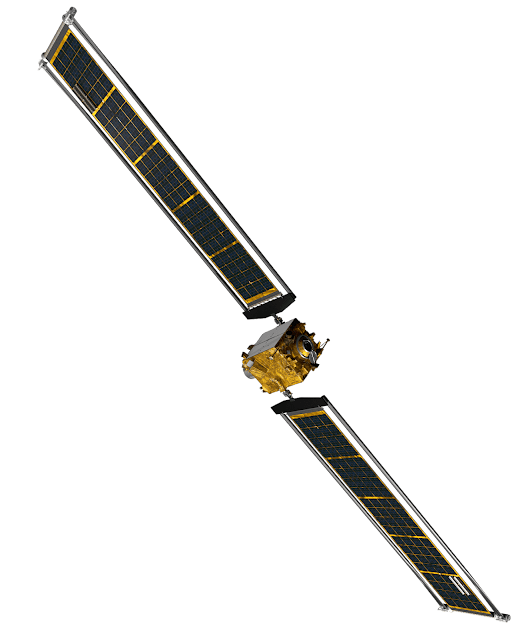SpaceX / NASA - Falcon 9 / DART Mission patch.
Nov. 23, 2021
Image above: The SpaceX Falcon 9 rocket with the Double Asteroid Redirection Test, or DART, spacecraft onboard, is seen during sunrise, Tuesday, Nov. 23, 2021, at Space Launch Complex 4E, Vandenberg Space Force Base in California. DART is the world’s first full-scale planetary defense test, demonstrating one method of asteroid deflection technology. The mission was built and is managed by the Johns Hopkins APL for NASA’s Planetary Defense Coordination Office. Photo Credits: NASA/Bill Ingalls.
A team of launch managers for NASA’s Double Asteroid Redirection Test (DART) mission have authorized approval to proceed to launch countdown at Vandenberg Space Force Base in California ahead of a scheduled launch on Tuesday, Nov. 23 at 10:21 p.m. PST (Wednesday, Nov. 24 at 1:21 a.m. EST) from the SpaceX Space Launch Complex 4.
During the Launch Readiness Review on Nov. 22, launch managers from NASA’s Launch Services Program (LSP), SpaceX, and DART mission team received an update on the mission status and any close-out actions from the previously held Flight Readiness Review. Signing the Certificate of Flight Readiness at the conclusion of the LRR were NASA’s Office of Safety and Mission Assurance; LSP’s chief engineer, launch director, and program manager; the U.S. Space Force’s Space Launch Delta 30 commander; the DART project manager; Johns Hopkins Applied Physics Laboratory director; and the SpaceX Launch Director.
Image above: Illustration of NASA’s DART spacecraft and the Italian Space Agency’s (ASI) LICIACube prior to impact at the Didymos binary system. Image Credits: NASA/Johns Hopkins, APL/Steve Gribben.
DART is the first mission to test technologies for preventing an impact of Earth by a hazardous asteroid. DART’s target asteroid in not a threat to Earth.
Teams also recently completed integration of the Falcon 9 rocket and its payload. After moving the DART spacecraft, encapsulated in its payload fairings, from the payload processing facility to the Falcon 9 Hangar, SpaceX technicians horizontally integrated the encapsulated spacecraft to the SpaceX Falcon 9 rocket over a two-day period, Nov. 20 to 21.
An illustration of the DART spacecraft. Image Credits: NASA/John Hopkins APL
“The payload mate onto the launch vehicle is an important milestone for DART because it is the final verification to ensure the spacecraft is communicating with its ground team,” said Notlim Burgos, LSP payload mechanical engineer. “This milestone also is significant for the LSP mechanical team because it integrates the last components of the launch vehicle, completing the build of the Falcon 9 in support of NASA’s first planetary defense mission.”
DART, NASA's First Planetary Defense Test Mission
NASA’s Launch Services Program, based at Kennedy Space Center in Florida, is managing the launch. The Johns Hopkins Applied Physics Lab manages the DART mission for NASA’s Planetary Defense Coordination Office as a project of the agency’s Planetary Missions Program Office. The agency provides support for the mission from several centers, including the Jet Propulsion Laboratory in Southern California, Goddard Space Flight Center in Greenbelt, Maryland, Johnson Space Center in Houston, Glenn Research Center in Cleveland, and Langley Research Center in Hampton, Virginia.
Related articles:
Catching asteroid deflection mission's first words
https://orbiterchspacenews.blogspot.com/2021/11/catching-asteroid-deflection-missions.html
Planetary defenders: after NASA’s DART comes ESA’s Hera
https://orbiterchspacenews.blogspot.com/2021/11/planetary-defenders-after-nasas-dart.html
Related links:
NASA Television: https://www.nasa.gov/live
Double Asteroid Redirection Test (DART): https://www.nasa.gov/planetarydefense/dart
Launch Services Program (LSP): https://www.nasa.gov/centers/kennedy/launchingrockets/index.html
Planetary Defense Coordination Office: https://www.nasa.gov/planetarydefense/overview/
Images (mentioned), Text, Credits: NASA/Patti Bielling/Video Credit: JHU Applied Physics Laboratory.
Best regards, Orbiter.ch




